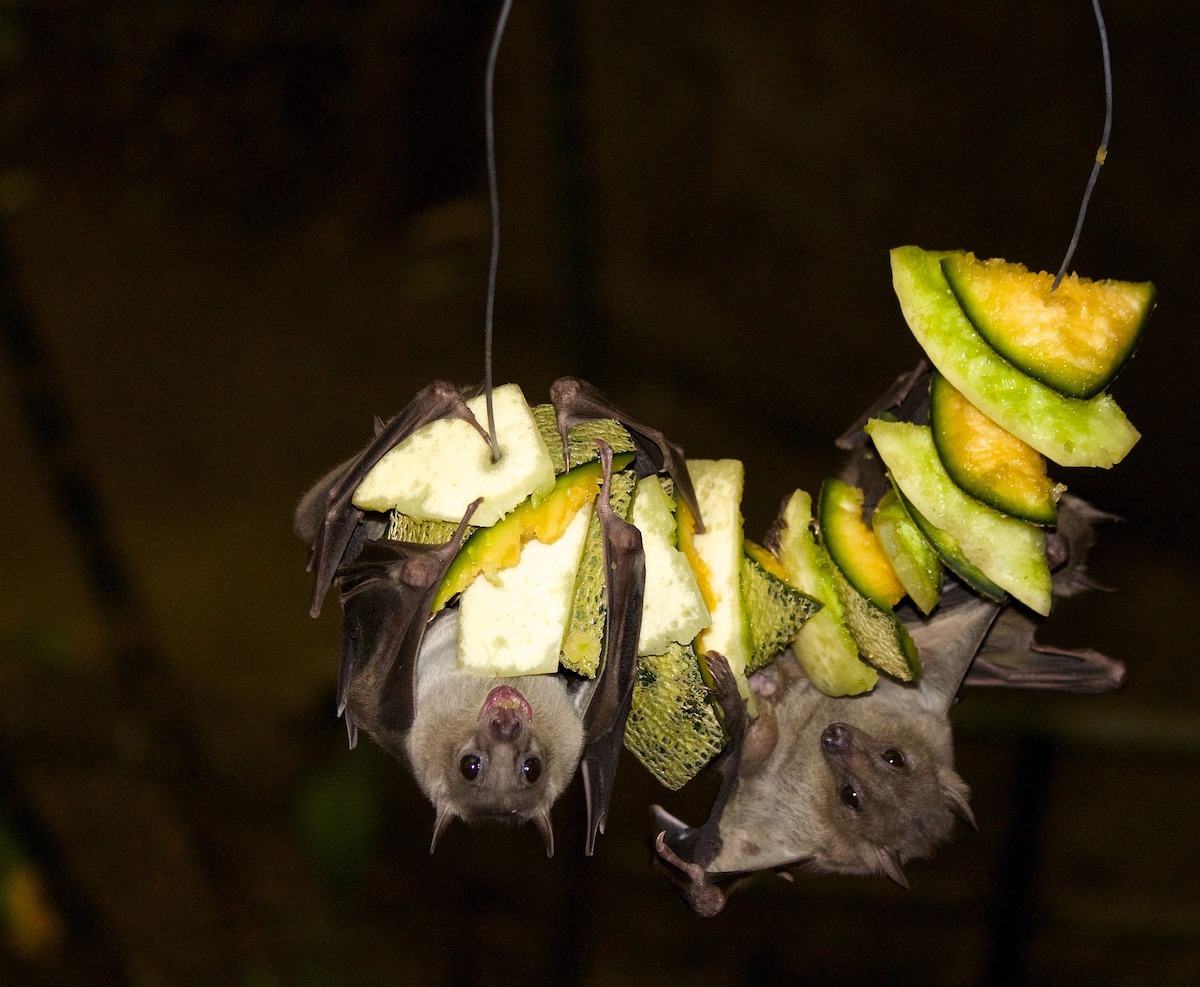 Evolution & Behaviour
Evolution & Behaviour
How does the bat find the tree? With a “cognitive” map!
Animals navigate around their home using a variety of strategies. The most advanced one uses a "cognitive map": having spatial memory of places relative to each other, the animal computes the direction to any previously-visited location from anywhere in its home range. We have shown that fruit bats seem to do exactly that, flying in long, exceptionally straight paths between any two locations.

As soon as the sun sets, hundreds of Egyptian fruit bats leave their cave and fly out, one-by-one, into the night. Their goal: trees bearing ripe fleshy fruits. They must consume more than twice their own body weight of this relatively uncommon and patchily-distributed resource each night, before returning home to their cave. How do they manage to do it efficiently?
Animals employ several navigational strategies for finding food or other resources. One is simply to search randomly, and then, once the resource is located, go straight back home using so-called path integration – an internal “recording” of one’s motion to then calculate the way back home. Some ants are well-known for using this strategy. For fruit bats, random search is not the most efficient: once found, a fruit tree never changes location and continues to bear fruit for days or weeks.
A goal-directed strategy would therefore do better. The easiest is probably beaconing, the ability to sense (by seeing, smelling, etc.) a target from the animal's current location to then move towards it. For targets beyond detection range, animals can use piloting, following a series of landmarks until the target is reached, as has been shown in homing pigeons. A piloting animal would most likely zigzag and spend more time and energy than it would by moving along a straight path. In addition, only a limited number of targets can be memorized and reached in this way.
A much more flexible, yet cognitively demanding, navigation strategy is to use spatial memory to locate objects or places. The memorized positions of the target and landscape features, relative to the animal’s current position, constitute an internal "cognitive map" from which one can compute a direction. With such a map in mind, previously-visited targets beyond detection range become easy to reach in a most efficient manner, usually a straight line. This ability is best exemplified by shortcutting – taking a novel route between any two previously-visited locations.
We, humans, use this strategy to move around, but what about other animals? Evidence for cognitive map-based navigation outside the lab, in free-ranging wild animals, was until now largely lacking. We set out to explore this scientific question studying the Egyptian fruit bat. Over four years, we tracked 172 wild Egyptian fruit bats in the Hula Valley, Israel, using miniaturized GPS-like devices temporarily attached to the bats by glue or collar. In total, we recorded over 9000 individual flight tracks between trees or between a tree and a cave. With this large, highly detailed dataset, we were able to tackle navigation-related questions that were impossible before.
What we found was quite astonishing! Regardless of track length (up to at least 23 kilometers) or target and origin (tree, cave, etc.), as soon as a bat leaves its home cave or a tree, it already knows where it wants to go and how to reach that destination. The flight tracks, on average, followed an almost straight line: we found almost no cases where random flight seemed to take place, even for our longest-tracked bat which we followed for more than seven months. The bats remain loyal to a few trees for weeks and, when visiting a new tree, they fly straight towards it. It is very unlikely that simpler modes of navigation, such as beaconing and piloting, generate these fantastic straight goal-directed flight tracks.
The bats also take new shortcuts, flying directly for the first time between two locations (caves or trees) which they have previously reached only from other places. These recorded shortcuts were, again, very straight, and indistinguishable from any other non-shortcut track. The record-holding bat in our dataset made one such novel shortcut more than five months after we started tracking it, indicating that their spatial memory lasts at least for that long.
Our findings strongly suggest that Egyptian fruit bats possess excellent long-term memory of the locations of many different individual fruit trees, and the ability to calculate their relative positions within the landscape. This allows them to build over their long lives a detailed cognitive map of their very large home range, enabling them to take the shortest, most efficient routes to these trees and back, over up to a thousand square kilometers. Truly remarkable!
Original Article:
Toledo, S. et al. Cognitive map–based navigation in wild bats revealed by a new high-throughput tracking system. Science 369, 188-193 (2020).Edited by:
Dr. Quentin Laurent , Senior Scientific Editor
We thought you might like
Shelling out for dinner: dolphins’ foraging technique spreads socially among peers
Feb 16, 2021 in Evolution & Behaviour | 3.5 min read by Sonja WildMore from Evolution & Behaviour
Cicada emergence alters forest food webs
Jan 31, 2025 in Evolution & Behaviour | 3.5 min read by Martha Weiss , John LillSize does not matter: direct estimations of mutation rates in baleen whales
Jan 29, 2025 in Evolution & Behaviour | 4 min read by Marcos Suárez-MenéndezThe Claws and the Spear: New Evidence of Neanderthal-Cave Lion Interactions
Jan 22, 2025 in Evolution & Behaviour | 3.5 min read by Gabriele RussoA deep-sea spa: the key to the pearl octopus’ success
Jan 20, 2025 in Evolution & Behaviour | 3.5 min read by Jim BarryFeisty fish and birds with attitude: Why does evolution not lead to identical individuals?
Aug 31, 2024 in Evolution & Behaviour | 3 min read by Lukas Eigentler , Klaus Reinhold , David KikuchiEditor's picks
Trending now
Popular topics


